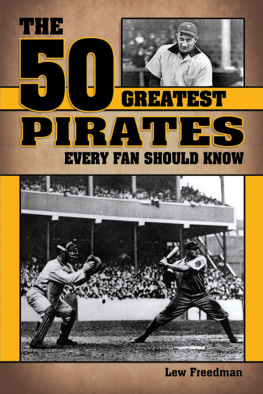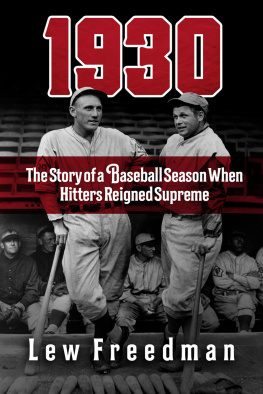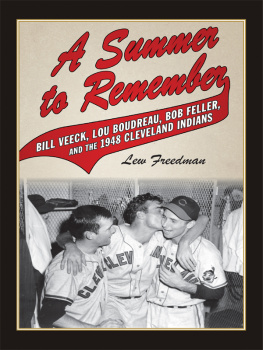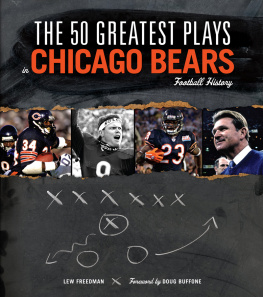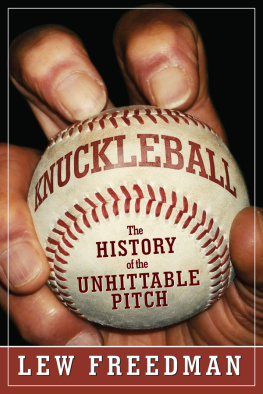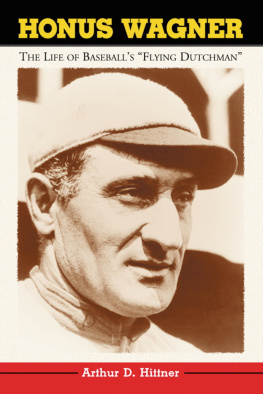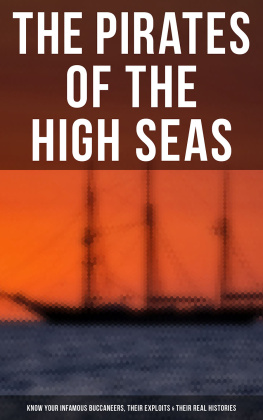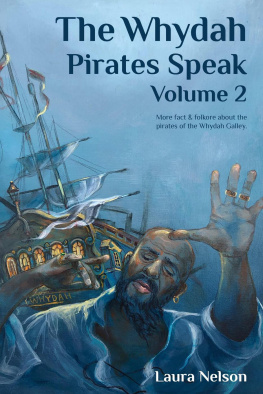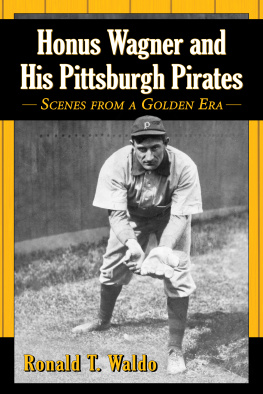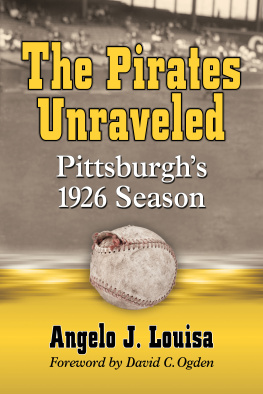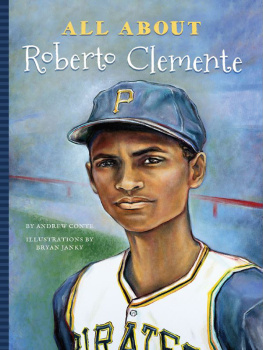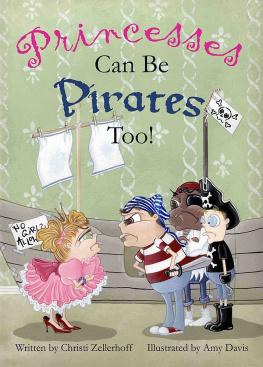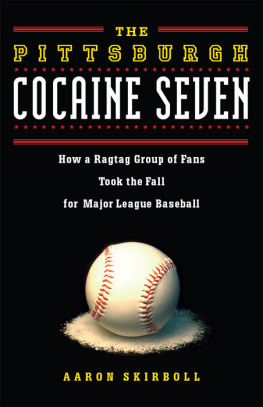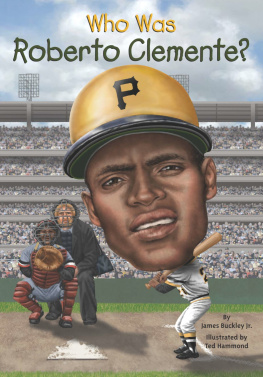The 50 Greatest Pirates
EVERY FAN SHOULD KNOW
Lew Freedman
Blue River Press
Indianapolis
www.brpressbooks.com
The 50 Greatest Pittsburgh Pirates Every Fan Should Know
Copyright 2014 By Lew Freedman
Published by Blue River Press
Indianapolis, Indiana
www.brpressbooks.com
Distributed by Cardinal Publishers Group
2402 N. Shadeland Avenue, Suite A
Indianapolis, IN 46219
317-352-8200 phone
317-352-8202 fax
www.cardinalpub.com
All rights reserved under International and Pan-American Copyright Conventions.
No part of this book may be reproduced, stored in a database or other retrieval system, or transmitted in any form, by any means, including mechanical, photocopy, recording or otherwise, without the prior written permission of the publisher.
ISBN: 9781935628330
eISBN 9781935628743
Cover Design by Phil Velikan
Cover Photos of Honus Wagner Courtesy of the National Baseball Hall of Fame Library
Book design by Dave Reed
Printed in the United States of America
10 9 8 7 6 5 4 3 2 1
Contents
INTRODUCTION
Having the nickname Pirates has always meant that the Pittsburgh baseball team had a sort of cool, swashbuckling look to it, even when nobody talked about baseball teams being cool.
Although the Pirates lost much of their dazzling allure between 1992 and 2012 when they recorded 20 straight losing seasons, the most among the four major sports in American history, the mojo seems to be back in Pittsburgh with the qualification of the 2013 team for the National League playoffs and scoring 90-plus victories.
From despair to giddiness, Pirates fans are back on the bandwagon. As one of the traditional franchises in baseball, thats the way it should be, and a whole new generation of heroes, led by Andrew McCutchen, is making nice with the Pittsburgh sports fan that was hungry for a winner.
The Pirates date their history uninterruptedly to 1882 when they were the Pittsburgh Alleghenys. The Alleghenys were first organized in 1876, but didnt hold together and then joined the International League six years later. While there have been gaps when pennants were rare commodities, the team has given the baseball world many prominent players worth cheering, and several notable, memorable teams, ever since.
They even have a former owner, in Barney Dreyfuss, in the Baseball Hall of Fame. Dreyfuss helped create the World Series and spearheaded construction of Forbes Field.
The Pirates played in the first World Series, losing to the Boston Red Sox. Dreyfuss bought the Pirates in 1900 and in order to stock the team he acquired 14 players from the defunct Louisville Colonels. One of those was Hall of Famer Honus Wagner.
Pittsburgh won its first pennant in 1901 and followed up with National League championships in 1902 and 1903. The first World Series was conducted in 1903, with the NL winner facing the fledgling American Leagues winner. Dreyfuss lobbied for the invention of the showdown to select a true champion.
The club won its first World Series in 1909 and won again in 1925. The Pirates won the NL pennant in 1927, but lost to the New York Yankees in that Series. That New York team was the Babe Ruth-led bunch known as Murderers Row, which some consider the finest single-season club of all time.
Some pennant drought years followed and there were some truly horrendous seasons in the early 1950s. When things were at their bleakest slugger Ralph Kiner arrived on the scene to provide some excitement. Kiner, a genial man, led the National League in home runs seven years in a row in the late 1940s and early 50s.
However, the Pirates captured Americas heart in 1960 when they won the title as underdogs against the New York Yankees. Bill Mazeroskis walk-off home run in the ninth inning of the seventh game might be the most important single hit in baseball history.
In 1971 the Pirates again fielded an appealing team that operated under the leadership of Willie Pops Stargell, which won another Series. Stargell was a player that young teammates listened to and who could energize a ball park with his home-run power.
A common theme between the 1960 club and the 1971 team was that Danny Murtaugh, the most beloved manager in team history, ran both squads.
In 1971, with no fanfare, Murtaugh became the first manager to field a team of all blacks. He didnt make a big deal out of itand neither did the players since some didnt even realize it until the game ended. But that was a milestone in a sport that was only a quarter century removed from banning participation of all African-Americans.
Manager Chuck Tanner led the Pirates to another world championship in 1979 with the We Are Family song by Sister Sledge borrowed as a theme song.
Along the way the Pirates have been blessed with many great players. Jake Beckley was the best player in the pre-1900 era. Wagner won eight National League batting titles and is usually picked as the shortstop on all-time teams. There is a statue of Wagner outside of the current Pirates home, PNC Park. Speedster Max Carey was a big contributor at the same time.
They were followed by brothers Paul and Lloyd Waner, both terrific hitters, who were called Big Poison and Little Poison and Harold Pie Traynor, one of the finest third basemen of all time.
Elroy Face was one of the sports great early relievers, able to shut down late-inning threats with his forkball.
Unlike some franchises where there is an undisputed No. 1 player in team history, while the nod goes to Wagner, there are definitely some true believers in Roberto Clemente. Clemente was not only a Hall of Fame player, but a Hall of Fame person who died in the act of a mission undertaken to help save lives. Clemente is also the player most admired by Latino players from all teams as a symbol of one of the first Hispanics to make it big in the regions favorite sport.
Over the years the Pirates played home games at Exposition Park, Forbes Field, which opened in 1909 as one of the first two steel and concrete stadiums constructed to replace flimsy wooden parks, then the less-favored Three Rivers Stadium, and finally PNC Park, right downtown. Three Rivers Stadium was an aptly named park in a city built on a point of land where the Allegheny, the Monongahela and the Ohio Rivers come together. But it was one of the unhappy cookiecutter-type stadiums that opened in the early 1970s. The round-shaped stadium, which also played host to the Pittsburgh Steelers, was drably interchangeable with stadiums in Philadelphia and St. Louis.
Some of the greatest Pirates pitchers were in the rotation long, long ago. Wilbur Cooper (202), Babe Adams (194), Sam Leaver (193), and Deacon Phillippe (167) were several of the biggest winners in Pittsburgh history, but retired decades ago. Vern Law, winner of the 1960 Cy Young Award, will always have a special place in the hearts of Pittsburgh fans for his 20-win season during that World Series championship year.
Although he only spent a portion of his career with the Pirates, Vic Willis did magical things with a baseball before 1910, his earned run average while representing Pittsburgh registering 2.09.
The task of choosing the top 50 players in Pirates history was a challenging one. Although the debate between Wagner and Clemente for No. 1 was not a riddle that could be avoided, most of the top ten was self-explanatory. The real battle always comes in determining if someone makes the list at all or cant pass the cut because the competition is too stiff.
Some very popular Pirates players are not among the top 50. Not because they werent good players, but because there were other players who arguably did more for the team during their stay.
Some players from so long ago that none of us still living remember anything about them have superb statistics and were intrinsic members of the Pirates a few generations ago. Some players we grew up with, were favorites, but dont have a strong enough record for inclusion. Occasionally a player remembered for significant contributions turns out not to have made even one All-Star team.
Next page
